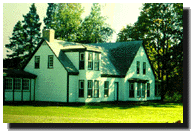
Five national historic sites are of special interest
in Prince Edward Island, including the site of Prince
Edward Island’s first European settlement and the
birthplace of Canadian Confederation.
Located in Rocky Point, across the harbour from
Charlottetown, Fort Amherst-Port La Joye National
Historic Site was the location of Prince Edward
Island’s first European settlement. Port La Joye was
first established in 1720 by French settlers. In 1758,
the British captured the fort and renamed it Fort
Amherst. Today, the only visible remains of the site are
the earthworks of the British fort. An interpretive
centre provides additional background on Fort
Amherst’s history.
The provincial offices for Parks Canada are housed at
Ardgowan National Historic Site. Ardgowan was the home of
William Henry Pope, a former premier of Prince Edward
Island and a Father of Confederation. The grounds
surrounding the building recreate a Victorian garden of
the 1860s and are open to the public.
Province House National Historic
Site was built in 1847 as Prince Edward Island’s
colonial building. It is most significant to Canadians as the
site, in 1864, of the first of three conferences that led
to the creation of Canada. Province House remains to this
day the seat of the Island’s provincial legislature.
Several rooms, including the Confederation Chamber where
the 1864 conference was held, have been restored to their
1860s appearance. An audio-visual display and
interpretive programs complement the building’s
historical appeal.
building. It is most significant to Canadians as the
site, in 1864, of the first of three conferences that led
to the creation of Canada. Province House remains to this
day the seat of the Island’s provincial legislature.
Several rooms, including the Confederation Chamber where
the 1864 conference was held, have been restored to their
1860s appearance. An audio-visual display and
interpretive programs complement the building’s
historical appeal.
Great George Street Historic District is a relatively
recent addition to Charlottetown’s historic sites.
In September 1864, the Fathers of Confederation landed on
the shore at the bottom of this street and eventually
made their way up Great George to the front of Province
House where the Charlottetown Conference was to be held.
Some of the visiting statesmen stayed in the Pavilion
Hotel that was located on the street.
 Sir
Andrew Macphail Homestead National Historic Site was
the home of doctor, teacher, soldier and writer, Sir
Andrew Macphail. The 140-acre home is restored to its
1912 appearance. Today it is the site of house tours,
storytelling, painting, genealogy, writing, crafts,
photography, dinner theatre, lectures, and ceilidhs. The
adjoining Macphail woods and native tree and shrub
nursery is a haven for naturalist education, offering
nature trails and workshops on forest restoration,
birding, and botany.
Sir
Andrew Macphail Homestead National Historic Site was
the home of doctor, teacher, soldier and writer, Sir
Andrew Macphail. The 140-acre home is restored to its
1912 appearance. Today it is the site of house tours,
storytelling, painting, genealogy, writing, crafts,
photography, dinner theatre, lectures, and ceilidhs. The
adjoining Macphail woods and native tree and shrub
nursery is a haven for naturalist education, offering
nature trails and workshops on forest restoration,
birding, and botany.

National Park | Scenic Heritage Roads | Museums and
Historic Villages
Historic
Buildings and Churches | Monuments
to Our Past